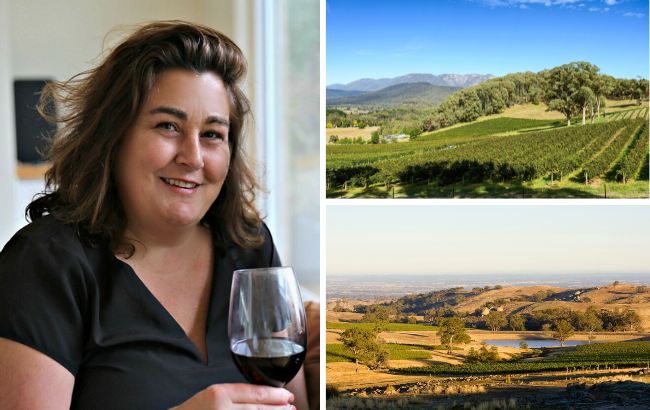Top 10 vineyard investments
By db staff writerVineyard investments can be a safe haven for investors in difficult times, but looking beyond traditional regions can unlock real potential.
With certain fine wines no longer representing the solid investment they once did, the next logical step is to gauge the investment potential of the land
Taking that global wine consumption will continue to rise, then identifying where the wine demand will pick-up and investing in that region, represents a solid strategy to maximise your money.
The smart money would now seem to be leaning towards investing in vineyards. But it is not a short term strategy, as it can take 10 years to establish one.
A major factor involved in the decision making of where to invest in a vineyard is the geographical region, as this can make a big difference to the value of its wine. A vineyard in a less prestigious area might be cheaper to buy, but the wine will sell for less.
Another sign to look out for when deciding what will represent an attractive vineyard region investment, is if big companies are moving into the area already. This is a good indication that the area is beginning to develop.
The price of vineyards are also dropping. In Bordeaux and Dordogne vineyards dropped by 14% in 2010 and fell by 18% in Montalcino, Italy.
New World regions showed a similar trend as prices fell by 23% in Hawke’s Bay, New Zealand, and 25% in the US’s Napa Valley.
The drinks business have come up with top 10 new vineyard regions around the world that may make a splash in the next decade or so.
1. CHINA
The East Asian state is on the cusp of something special in wine circles and it offers huge potential for growth of investment in their vineyards.
Last year US wine exports to China grew by 42%. Within three years, greater China will spend more money on still wines than the UK, and become the world’s second biggest wine consumer by value, after the US.
This all points to a huge opening on the Chinese domestic wine market. Consumption of wine by China and Hong Kong increased by over 100% between 2005 and 2009, from 46.9m to 95.9m cases. This figure is expected to increase a further 20% by 2014, to 126.4m cases.
According to Vinexpo – in terms of domestic production of wine, China is set to increase by 77% over the next four years, from an average 72m cases to 128m cases.
Already big drink companies are seeing the potential in the Asia market. Domaines Barons de Rothschild has begun construction of a winery in Penglai in China’s Shandong province in order to capitalise on the thirst for fine wine in Asia. And there are reports that China is warming to white wine too.
One good tip is that the potential of the Chinese market lies in the less-affluent regions.
2. Tasmania
Tasmania is the only Australian state where its entire grape production is genuinely in a cool climate.
At the recent 8th International Cool Climate Symposium for Viticulture and Oenology (ICCS) it was said that Tasmanian wines are “punching considerably above their weight” in relation to the tiny fraction of national production and the relative youth of the current industry.
This all points to an area that is worth watching in terms of vineyard investment.
While vineyards are being removed in other parts of Australia, the Tasmanian wine industry is enjoying modest growth, with recent investments confirming Tasmania’s position as a premium cool climate wine region.
It is a particularly attractive investment location for those seeking to expand or diversify their businesses, due to the region’s cool climate, affordable land, abundant water resources and relative pest and disease freedom.
Interesting government economic development strategies also add to the notion that this would be a good investment, as the Tasmanian wine industry has been identified as having strong potential for expansion.
Tasmania is “the new, exciting frontier” for Australia, according to Ross Brown, owner of Brown Brothers.
3. Greece
In terms of vine procurement and growth, Greece has the weather and topography for great wine to be produced.The current Greek government debt crisis could potentially leave vineyards available for cheap.
Its prime Mediterranean location and a history of wine production that dates back more than 5,000 years, means that Greece always has the potential to a top wine producing country.
Testament that Greece can still produce a worthwhile wine is the fact that stylish Greek wines have been trickling onto prestigious restaurant lists in the US.
4. Georgia
The country has evolved in terms of wine marketing and exporting after Georgia became independent shortly before the collapse of the Soviet Union in 1991. About 90 percent of Georgian wines were sold to Russians. That steady customer base ended in 2006 when Russia broke off relations with Georgia after its leaders indicated a desire to join NATO. Now, the wine is exported to more than 20 countries and can be found in New York and Washington, D.C.
With this in mind, Georgia has a good long-term investment outlook.
Georgian wine can be produced in quite a cost-effective manner. Many winemakers in the region still follow the old tradition of fermenting and aging wine in 4,000-liter quevris, or large clay vessels, that are buried in the ground. Quevris are cost-efficient, if not very scientific and it produces good concentrated red wine.
Award winning wine taster Isabelle Legeron MW is a big advocate of Georgian wines. “There are grape varieties here that do not have a parallel anywhere in the world, the Rkatsiteli for example.” But she also reminds that some work needs to be done in terms of marketing. “It is time for Georgian wine labels to be redesigned, but always keeping them simple… same with the bottles…”
Partner Content
Georgia will be represented at RAW, an artisan wine fair for fine, organic and biodynamic wines this May.
5. Languedoc
The Languedoc countryside around the town of Carcassone offer potential long term investment options.
The climate, topography and terrain-types of Languedoc Roussillon are surprisingly diverse. The foothills of the Pyrénées, Montaignes Noirs and the Cévennes combine the best of both worlds – warm temperatures and beautiful scenery.
The notion that anyone might buy Languedoc vineyards as an investment may seem optimistic. But hope, for the Languedoc, lies in a new generation of wines produced not on the plain but in the hills.
The investment potential may be a little premature – the 2011 harvest in the Languedoc led to a grape price rise to a 10-year high.
However, it seems plausible that the best sites of the Languedoc might, a few decades hence, produce red wines to challenge the best from Côte Rôtie, Cornas and Châteauneuf.
6. England/Wales
This is being a little optimistic, but English wine has been a steady incline over recent years and the drinks business has already tipped it to make an impact this year as one if its top 10 trends of 2012.
The year of the Olympics and the Queen’s Diamond Jubilee gives English Wine Producers (EWP) a key platform to build their brand on the world stage.
Increasing numbers of English wines are being listed and sold in the UK and EWP reported that at the present rate, by 2015 volumes will have increased to five million bottles. This all points to long term investment potential in English vineyards.
In terms of vineyard regions, the chalk hills of Hampshire are beginning to be seen as an ideal environment to produce an English sparkling wine that is similar to Champagne. The white wine and sparkling wine produced in this region can be characterised by their clean, crisp and fruity flavour.
Sainsbury’s recently announced the addition of an English sparkling wine to its Taste the Difference range, Ridgeview is to produce a sparkler for Waitrose’s own range and the industry has been buoyed by a good harvest in 2011.
Welsh wine is growing in popularity and critical acclaim. Welsh Government deputy minister for Agriculture, Food, Fisheries and European Programmes, Alun Davies said:“Compared to some traditional wine growing regions Wales may be a relative new-comer, but in terms of quality and potential, Welsh wine is certainly making a name for itself at home and abroad.”
Awards have been presented to some Welsh wines. At the 2011 International Wine Challenge, the Tintern Parva Bacchus 2009 won a silver award. Ancre Hill Estates, which picked up two trophies at the 2010-11 Wales the True Taste Food and Drink Awards, is a producer of traditional varietal sparkling wine, with its first release due in 2014.
7. Ukraine
The Ukraine has a lot of potential as there is continuing development in the region in terms of vineyards and grapevines.
After an almost complete lack of foreign wines in Ukraine before independence, the import of wine began in the early 1990s with a simultaneous drop in Ukrainian wine production.
Wine import became more or less regular over the 1990s. This has seen something of a sea change as wine production volumes have grown over the last several years since the 1990s. The most significant growth, as reported by official statistics, was in the period 1999-2002.
This year alone it has been predicted that 332,000 grapevines will be bought to establish new vineyards. This leaves a lot of potential for investment.
A key feature is that quality control is becoming important in the region, so that good quality wines can be produced more often.
8. Sardinia, Italy
In Sardinia the old mantra of soil, sunshine and soul still holds through when making good wine.
The ancient Greeks nicknamed their colonies in the South of Italy, Oenotaria, the land of wine.
Sardinians have sharply reduced vineyards and volume of production recently while notably improving the general quality of their wines, giving into the notion that the potential for vineyard investment is viable here.
The island’s most productive vineyard area is the Campidano, the fertile plains and low rolling hills north west of the capital and major port of Cagliari. The varieties grown there are Girò, Malvasia, Monica, Moscato, Nasco and Nuragus.
A rising star among red wines is Carignano del Sulcis, from the southwest, where certain wineries have emerged with notable style.
This year, a consortia from Sardinia, Emilia-Romagna and Piedmont will be exhibiting at the LIWF.
9. Swartland (South Africa)
Swartland’s growth from five wineries 10 years ago to almost 30 in 2011 smacks of a region that’s booming. Winemakers, working with Chenin Blanc and Rhône varieties, off the beaten path in Swartland are beginning to make a name for themselves.
Showcasing intense fruit, freshness, concentration, and elegant textures Swartland wines consistently reach new heights.
The most intriguing thing about Swartland is that it has the highest number of old vineyards per capita in South Africa and can produce incredibly high-quality fruit.
There’s been notable success with grapes associated with France’s Rhône Valley. But there’s also some fine Chenin Blanc around, on its own and in blends such as Mullineux White Blend 2009 and Lammershoek Roulette Blanc 2009.
Su Birch, CEO for Wines of South Africa, is equally enthusiastic about the Swartland. “New wine investment usually comes to Stellenbosch with restaurants and wineries. This is the opposite: younger people, not big capital, bringing back to life old vineyards and varieties which are either new or not usually treated with respect.”
A major reason why Swartland is an up and coming vineyard investment opportunity is that the Southern Hemisphere provides an unobstructed seasonal opportunity to work in Northern Hemisphere winemaking regions with non-conflicting growing calendars.
10. Finland
As of 2010 in Finland there were 40 wine producers bottling reds, whites, and roses without so much as a grape in sight.
In terms of grapes and the prospect of Finland developing into a region of vineyard investment, there are a number of factors to consider.
- There are more grape varieties available which are suited to cool climates – cold winters and short growing season. Some of varieties tolerate -35°C and even -40°C temperatures.
- Winter protection makes possible growing of sensitive vine varieties.
- Present global warming moves the boundaries of northern winegrowing to the north which makes northern winegrowers’s work much easier.
- One major stumbling block is that Finnish wine products are not taken seriously because Finland does not have an image as a wine-maker.
-
- Finnish vineyards in a blanket of snow





>> 4,000-liter quevris, or large clay vessels, that are buried in the ground. Quevris are cost-efficient, if not very scientific and it produces good concentrated red wine.
First of all, quevris are of different size, not obligatory 4000 l. I’m not sure what’s the cost-efficiency of the quevris (they are cheaper than oak for sure) but from scientific point of view they are a vessel with high oxydizing potential (clay is porous and the quevris are not coated from the inside as a rule) so the wine inside tends to oxydize fast and die even faster (given that no topping-up is previewed by the “cost-efficient” system – see picture). Some of the wine is kept with the stems for a longer time than you can imagine. Not a single Georgian winemaker could answer my question how on earth they clean to sterility a porous uncoated vessel that is buried in the ground. As the answer is – there’s no way. So at the end you get a very … ahmm … specific wine, biologically unstable (in the better case, in the worse – contaminated by mould, fungi and other unknown bacteria) and oxydized, that tends to “dismantle” very fast. But, of course, it’s “natural”, “cost-efficient” and with the so called “gout de terroir”. In general the contemporary consumer refuses to drink such wines (I mean the taste as a whole) and that’s why Georgia can’t sell abroad even half of what they were selling to Russia (as Russians drink everything that burns, i.e. contains alcohol, and don’t care).
There are some interesting new wines though, but none the less they are a niche product, only for connoisseurs. Not sure if this is enough to put Georgia among the Top-10 emerging wine regions.
Good to see Vinifera representing. Valid points Bisso.
I have tried quite a bit of Georgian wine and have only had bad experiences with wine from quevris. The ones I have tried have had very odd aromas, the wines have been very vegetal and poo-ey, not in a Burgundian farmyardy way, but very unpleasant. Maybe I have just been unluck so far.
Huge ommission – Argentina has to be included. Terroir very accessible and available in Mendoza region. Weather dependable and most vineyards are at elevaton in Andes foothills imparting extraordinary qualities. Malbec is taking over the red wine world with Cab close second. Costs, compared to many locations, are very low with lots of room to grow.
I follow the following simple filosophy : Life is to short to drink bad wines.
Why bother to drink this awfull wines?
HI, I’m french winemaker and owner, sébastien wiedmann ; I’m looking for 1 or 2-3 people who wants to invest in wine business in the Rhône Valley….saint-Joseph, Crozes-Hermitage, Cornas, Cote-Rotie and Condrieu….please answer to : sebwiedmann@gmail.com
My friends are Chapoutier, Guigal, Delas, Jaboulet, vins de Vienne, Cuilleron and many more…..
This is a bottle sent to the see……
Hope to ear from somebody
Thanks a lot
S WIEDMANN
Does anyone know wine investors?